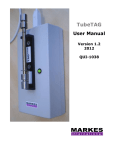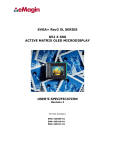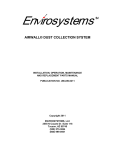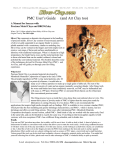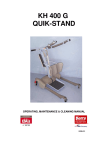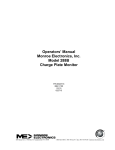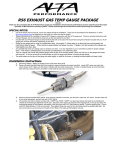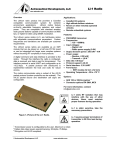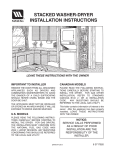Download to see the Enviro-Klean brochure - Enviro
Transcript
w w w. e n v i r o k l e a n . c o m Enviro-Klean - 1980’s to Present Enviro-Klean’s Roots Back in the 1980’s, manufacturers of asphalt plants began modifying their equipment to remediate hydrocarbon contaminated soils. The process was effective, however, fuel consumption and undesirable air emissions presented significant challenges. As a result, a group of engineers joined forces under the name Enviro-Klean and began to explore alternate soil heating methods. They created the unique EnviroKlean soil curtain design, which has been modified and improved through 4 generations. Each new enhancement has increased the throughput, reduced energy consumption and improved air emissions. Today’s model, the KM-4, is a testimony to the company’s unceasing pursuit of perfection. This second generation Klean Machine was designed and built in 1994 Material Feed Air Filter Soil Processor Certified Engineering and Manufacturing Enviro-Klean equipment is engineered and manufactured in North America, and meets UL, CSA and European CE standards. All machine components are designed for years of productive service. (The KM-2 pictured above was built in 1994 and is still in operation.) The drives and gear boxes used to power the screw conveyors and augers are top-of-the line Eurodrive and Baldor. The electronics are Siemens. The fuel system is Eclipse. The heavy-duty trailers feature air-ride suspensions. Enviro-Klean is committed to providing competitive, state-of-the-art thermal remediation equipment that meets or exceed the toughest environmental standards world-wide. For Additional Information on Thermal Desorption The US Navy has commissioned hundreds of clean-ups, and has complied an intensive analysis of this technology, titled “Application Guide for Thermal Desorption Systems.” It includes the following topics: 1. When to Use Thermal Desorption 2. Design and Performance Characteristics 3. Cost Data and Project Estimating Methodology 4. Regulatory Compliance Issues 5. Case Studies You can review a copy of this report on the Enviro-Klean website at: www.enviroklean.com/USNavyReport 2 w w w. e n v i r o k l e a n . c o m Oxidizer How Does It Work? The Enviro-Klean thermal desorber is effective for removing hydrocarbon contamination from the soil. Hydrocarbons volatilize when heated to their boiling point and subsequently convert to water vapor and carbon dioxide in a thermal oxidizer. The net result is reusable clean soil. What Can it Clean? The Enviro-Klean thermal desorber can clean gasolines, jet fuel, kerosene, diesel, lube oil…virtually any petroleum product. In addition, with modifications, these versatile machines can clean soil containing pesticides, chlorinated compounds, plus recover entrained oil in drill cuttings. Patented Soil Processor Design The Patented Enviro-Klean Processor Thermal desorption machines share three common features: 1 ♦ a processor for heating the soil to release the contaminants, ♦ a oxidizer or condenser for removing the organics, ♦ a baghouse for containing the particulate. 2 Most thermal machines use a double-shell rotary drum to heat and volatilize the contaminants. The residence time for soil in the drum averages 6 to 12 minutes—depending on soil type, moisture, contaminant, etc. 3 Enviro-Klean has a patented soil-curtain processor with an average residence time of about one minute. Contaminated soil falls in thin layers between the processor chambers—which allows for maximum heat transfer between the heated air and the soil. There are three primary savings with this system: ♦ less energy is required to heat the contaminants, ♦ soil moves through the processor faster which allows the Enviro-Klean machine to do the same job as one twice its size, ♦ the airstream is considerably smaller making it easier to control. The net result is Enviro-Klean’s ability to put all three of the necessary thermal desorption components on a single highway-legal trailer—making the system smaller, less expensive to operate and significantly reducing the capital cost. 4 Back view of KM-3 design during construction showing narrow, compact processor (chambers are numbered 1 through 4). 1 2 3 Side view of a KM-3 design during construction showing three of the four processor chambers. Soil Curtain Inside view of a processor chamber showing the screw, trough, and drop zone. Soil cascades down through the processors, while heated air volatilizes the contaminants. w w w. e n v i r o k l e a n . c o m 3 Enviro-Klean KM-4 The Standard for Fuel Efficiency Patented Processor Saves 50% on Fuel Costs KM-4 DIMENSIONS* Traditional rotary kiln thermal desorbers use twice as much fuel for the same throughput as the KM-4. Here is how the KM-4 design squeezes every drop of potential from its burner fuel. • The processor and thermal oxidizer walls are foam insulated, which is up to 3 times more effective than hard refractory. Radiation losses are minimal. • The cascading soil design helps to volatilize the hydrocarbons at 30% lower airstream temperatures. • And since the airstream is half the volume of a rotary kiln, less energy is required to destroy the hydrocarbons in the thermal oxidizer, and less energy is needed to cool the air prior to the baghouse. The result of these design enhancements provides today’s thermal remediation market with the fastest throughput, the lowest operating cost, and the most advanced options for remediating difficult hydrocarbon contamination. In-feed Hopper Thermal Oxidizer Burner Thermal Oxidizer Transport: • Highway-legal on most commercial transport roads world-wide. Trailer mounted: • Includes material processor, thermal oxidizer, heat exchanger and baghouse • 16 meters (53’) • 4 meters (13’2”) • 2.5 meters (8’2”) • 33 tonnes (73,000 lbs) Trailer Length: Equipment Height: Trailer Width: Total Weight: *Note: Due to on-going product upgrades, specifications and designs are subject to change without notice. Items shipped may differ from those described in this catalog. Multi Clone Heat Exchanger Baghouse I.D. Fan Burner Assembly 4 w w w. e n v i r o k l e a n . c o m Enviro-Klean KM-4 Portable and Reliable Compressor Electrical Panel Processor Assembly The Ultimate, High-Capacity Portable Thermal Desorber The Enviro-Klean KM-4 is designed to minimize nonproductive time. For faster mob/demob, the width and height dimensions are within North American and European road regulations. The trailer connects to any heavy-duty truck and is immediately ready for transport. Set-up is straightforward. Unlike rotary kilns, there is no cumbersome ductwork to connect, and no large cranes needed to position the skids. Instead, the trailer is towed by the truck to a suitable, reasonably-level site. Then a few smaller components, notably the material feed and discharge system, are set in place and the equipment is ready for operation. Cost-Effective for Smaller Projects The KM-4 is especially effective for smaller remediation projects and rapid turn around times because it can be set up in less than a day. Competing equipment often requires a week or more, which adds significantly to the project cost and manpower requirements. When small projects are time-consuming and costly, the contaminated soil is frequently trucked to a central site or a landfill—relocating the problem elsewhere and necessitating new fill material. This option is environmentally unfriendly and potentially dangerous. Material In-feed Preheater KM-4 SPECIFICATIONS* Nominal Feed Rate: • 18-27 tonnes (20-30 tons) per hour Contaminants: • Hydrocarbons to 25,000 mg/kg and to Carbon Chain 40 at reduced throughput Moisture: • 20% maximum recommended (<15% preferred) Processor Temp: • 315-930°C (600-1700°F) Fuel: • Propane, natural gas or #2 fuel oil • <100 ppm to non-detect CO: VOCs: • Meets legal requirements for destruction (99% to non-detect) Thermal Oxidizer: • Direct Thermal 1-2 seconds residence time @900°C (1650°F) Soil Classification: • ASTM D2487-83, GW, GP, SW & SP Petroleum Contaminated Soils Cleaned to: MTC Act Table V Class 2 Levels *Under controlled conditions Note: Throughput varies depending on soil moisture, soil type, contaminant type and level. See the Enviro-Klean website for additional information. w w w. e n v i r o k l e a n . c o m 5 Training - Service - Warranty Training Enviro-Klean equipment is easy to learn and manage. It can be run by one operator and helper. Training is available when the machines are tested prior to shipping, and include a comprehensive training manual for reference. All the startup and shutdown controls are at a single station, and include temperature monitors for various processor chambers, the baghouse inlet, and the thermal oxidizer. The machine can be operated in manual, or automatic mode. Service Enviro-Klean machines are built from heavy duty components, and with proper maintenance, seldom require more than regular greasing and inspection of moving parts. They are shipped with a detailed service manual, and require approximately 2 hours of service for every 24 hours of operation. Machine controls feature readily-available, offthe-shelf components, with an emphasis on quality. When necessary, a factory rep will travel to the machine jobsite to inspect and repair the equipment. The KM-4 control house offers the ultimate in air-conditioned comfort. Dual touch screen monitors allow the operator to view all important machine functions simultaneously, and at the same time, have a clear line-of-sight to all the material feed and discharge processes. Equipment Warranty Enviro-Klean warrants to the original buyer that all new equipment and material manufactured or designed by it shall be free from material defects in design and fabrication for a period of one (1) year from the date of shipment. Production Warranty Enviro-Klean warrants the soil plant production to meet the noted production rate subject to the following criteria: oil contamination in the soil not to exceed 80% of the processor and oxidizer fuel load, burner fuel to be natural gas, liquid propane or #2 fuel oil, plant operation at 150 meters (500’) elevation or less, soil gradation to be equal or less than 33% fine material (equal to 63 micrometer), density of the soil to be equal to or greater than 1.09kg/M3 (85 lb/ft3), soil specific heat equal or less than .22, and when the plant is set up and operated according to the sellers instructions 6 w w w. e n v i r o k l e a n . c o m KM Options and Feed System KM-4(EU) - 380V, 50Hz Option KM-4(SS) - Stainless Steel Option North American KM-4 machines are designed for 460V, 60Hz electricity. For Europe a 380V, 50Hz system is available. Although all high temperature components of the KM-4 (processor, oxidizer, heat exchanger, ducting) are manufactured using appropriate grades of stainless steel, for corrosion resistance or when running chlorinated compounds, an all stainless machine can be the best option. KM-4(MF) - Multi-Fuel Option The basic KM-4 operates on propane or natural gas. It can be optionally modified to use #2 fuel oil, and also be configured as a combination gas/oil system. KM-4(GS) - Genset Option KM-4(HC) - Scrubber Option Halogenated compounds may require additional treatment in a scrubber system to remove contaminants like chlorine, fluorine, or bromine from the vapor stream. The KM-4 is fabricated with provision for a scrubber to be added—either when the machine is ordered from the factory, or later when required. The KM-4 can be connected directly to grid power, or optionally to an appropriately-sized generator set. KM-4(FS) - Feed System Option KM-4(OR) - Oil Recovery Option It is highly recommended that the KM-4 is used together with the integrated feed, trommel screen system designed to blend, dry, and meter the feed stock. However, the KM-4’s electrical and electronic system can be configured to manage other material feed designs. When the feed material has hydrocarbon concentrations above 100,000ppm, it can be cost-effective to select the oil recovery option. This model condenses the airstream and collects the volatilized hydrocarbons for reuse. Feed and Discharge Conveyor - Pictured here is a typical custom feed and discharge system that works with all Enviro-Klean models. It includes a 5 yard hopper, a <5mm (2”) trommel screen, and a telescoping feed conveyor that reaches to the in-feed hopper on top of the KM-4. The discharge conveyor is 7 meters long (23’), and carries soil from the pugmill away from the machine. All the components fit on a single highway-legal trailer for transport. w w w. e n v i r o k l e a n . c o m 7 KM-4 Operation Feed Stock Preparation Trommel Screen Crossbelt Dump Hopper Grizzly Belt Scale Feed Conveyor Discharge Conveyor Feed Hopper Thermal Oxidizer Pugmill Preheater Processor KM-4 Primary Components The entire KM-4 thermal desorber, including the feed system is contained on two trailers. The components include: grizzly, dump hopper, trommel, weigh belt, infeed conveyor, feed hopper, preheater, processor, pugmill, discharge conveyor, multi-clone, heat exchanger, baghouse, I.D. fan, compressor, genset, and control house. Feed Stock Preparation The KM-4 feed system is compact and mounted on a single highway-legal trailer. Various feed and discharge components are stored or folded to facilitate transport. This custom-designed system screens and blends feedstock before allowing it to enter the soil processing section of the equipment. A <10cm (4") grizzly keeps oversized material out of the dump hopper. The debris is cleared remotely by the loader operator. A cross belt conveys material to the <5cm (2") rotating trommel, which aerates, blends and reduces moisture before screening the material onto the feed conveyor. En route to the processor, the feedstock is first weighed on a computerized belt scale, and then deposited into the feed storage hopper. This hopper is fitted with an automatic sensor that both controls the feed rate and also maintains a front-end material seal. 8 w w w. e n v i r o k l e a n . c o m End view of feed trailer system showing the inside of the trommel screen with the opening into the dump hopper KM-4 Operation Contaminated Feed Handling Contaminated Feed Handling The KM-4 handles contaminated material efficiently by heating it quickly to volatilize the hydrocarbons. This starts in the triple-purpose pre-heater. It meters the flow rate into the processor; it draws excess heat from the thermal oxidizer to begin raising the material temperature, and the twin screw design further mixes and blends the feed material. Contaminated material passes from the top to the bottom of the processor through a series of heavyduty screw conveyors. As the material drops between chambers, the finer particles, which have the highest hydrocarbon contamination, are exposed to the crosscurrent flow of hot air from the burner. After passing through the processor, the cleaned soil is discharged into the pugmill, where it is mixed with water for cooling and dust control. The pugmill, in turn, deposits the cleaned material on to the discharge conveyor that stacks it for immediate or future use as clean backfill. At the junction between the lowest processor screw conveyor and the pugmill is a material temperature sensor, which controls the feed rate for the entire system. This sensor maintains a preset discharge temperature and makes certain the contaminated material is cleaned to environmental standards. Particulate Handling Because the feed material is thoroughly dried to volatilize the hydrocarbons, there is always a particulate component to the airstream. It is highest with finely textured materials like clay. This particulate must be removed before the airstream is filtered back into the atmosphere, and the KM-4 has a number of tightly engineered systems to extract the particulate from the air, clean it, and discharge it with the balance of the treated material. Contaminated Particulate Some feed material exits the processor as particulate in the air stream. Approximately 90% is collected by the multi-clone and conveyed back to the processor for further hydrocarbon removal. Multi-clones are more efficient than cyclones and occupy about onequarter of the space for a given particulate removal requirement. The KM-4's multi-clone removes nearly all the particulate down to 50 microns. End view of the Enviro-Klean processor Contaminated feed enters the top of the unit and cascades down through a series of chambers until the material is cleaned. On the lower left is a gas/oil processor burner. Clean Particulate Handling The thermal oxidizer eliminates all hydrocarbons from the air stream, however the airstream has a small amount of particulate that is conveyed to the pugmill for discharge. The heat exchanger/baghouse also collects a small amount of clean particulate, and this is also conveyed to the pugmill for rehydration and discharge. The material handling systems described above make certain that contaminated materials are cleaned to environmentally safe standards and that all material discharge from the KM-4 is immediately suitable for backfill. w w w. e n v i r o k l e a n . c o m 9 KM-4 Operation Air Flow The Air Flow Overall, the KM-4 uses about half the energy to clean the same volume of soil compared with a rotary kiln. This is accomplished by carefully manipulating the airstream to extract maximum heat transfer from the hot air to the material, the volatilized hydrocarbons, and the air-cooling and cleaning system. Heating the Material The primary system burner is located at the base of the material processor, and operates on gas or oil. It has a dedicated combustion chamber that assures proper development of the flame and utilization of the combustion air. The entire processor is completely foam insulated to minimize radiant heat loss. An I.D. fan pulls the air through the system. As the hot air travels through the screw conveyor arrangement in the processor, most of the heat is transferred to the material. This volatilizes the water and hydrocarbon liquids, which are ducted from the top of the processor to the thermal oxidizer by way of the multi-clone. The KM-4 uses the latest generation of high-temperature, pleated filter elements to retain particulate within the system. The bags are pulse-jet cleaned and the particulate is discharged and rehydrated together with the cleaned feed material. Destroying the Hydrocarbons The thermal oxidizer has a secondary burner that raises the airstream temperature to 900C (1650F) in order to destroy the hydrocarbons liberated from the feed material. In other systems, the hot air is cooled, cleaned and then discharged from the system. The KM-4 is unique because it uses a patent pending preheater that absorbs the thermal oxidizer's hot air to raise the temperature of the in-coming feed material. Air Cooling and Cleaning After exiting the thermal oxidizer, the hot air is cooled in an air-to-air heat exchanger. This device requires no energy except for a fan to supply ambient air to the process. The heat exchanger is required to protect the baghouse filters, which in the KM-4 are a recent innovation that allows high temperature pleated elements. The pleated filters significantly reduce the space requirements of the baghouse while delivering the same particulate removal as traditional filter systems. The thermal oxidizer, heat exchanger, and baghouse are about half the size of conventional thermal systems with the same throughput because less heat is required to raise the material temperature and volatilize the hydrocarbons. 10 w w w. e n v i r o k l e a n . c o m Heated air from the thermal oxidizer is cooled by a proprietary heat exchanger prior to entering the baghouse. A VFD-controlled blower provides the correct volume of cooling air to the system. KM-4 Operation System Controls System Operation The KM-4 employs up-to-date control technologies for trouble-free, efficient operation of the equipment. These include touch screens for the operator, remote temperature and pressure sensors, and motors equipped with variable frequency drives. Control House The air-conditioned control house is designed for the comfort, safety and efficiency of the operator. In it, the operator has complete control over the entire system, from material feed and discharge, to combustion air input and flue gas exit. The KM-4 is capable of fully automatic operation, which optimizes the feed rate and the fuel usage. The entire system is controlled by the discharge soil temperature, which is set by the operator and based on prevailing environmental standards. Motors are powered by variable frequency drives which allow incremental adjustments to the feed material and air flow rates in all parts of the equipment. The KM-4 has more than 20 temperature and pressure sensors and other thermocouples that monitor the various functions of the system. Together with the VFDs, they help the operator achieve the highest possible throughput with the least consumption of fuel. The variable frequency drives for all the unit’s motors are housed within the control house and cooled by a dedicated air-conditioner. The image at the right shows the quick disconnect panel on the outside wall of the control house. System Power Either grid power or a genset is used to power the system. For North American applications, the power supply is 460V, 60Hz. For Europe, it is 380V, 50Hz. The genset is sized to power all the KM-4 and feed system motors, with extra capacity for lighting and incidental tools. Similarly, the air compressor which supplies air to the pulsejet baghouse, also has additional capacity for burner operations and other air-powered equipment. The computer system includes a backup plus a means for logging all the input and output data received from the various drives, thermocouples, and other sensing devices. In all, the KM-4’s control system is the finest available today. It uses world-leader, Siemens components to assure dependable performance and product support world-wide. All electrical connections are designed to withstand extremes of temperature and the rigors of on-site conditions. This set of connectors integrates the feed system motors with main processing unit. w w w. e n v i r o k l e a n . c o m 11 SOURCE EMISSIONS TESTS The following KM-3 tests were conducted in accordance with Environmental Protection Agency (EPA) standards as defined in document Title 40, Code of Federal Regulations, Part 60 (40 CFR 60), Appendix A, Methods 1, 2, 3A, 4, 5 and 25A, and Puget Sound Air Pollution Control Agency (PSAPCA) Method 5 back-half extraction procedures. The independent testing laboratory, AMTEST, of Washington State ran three (3) 60-minute tests. The TDU processed 11-12 CY of soil per hour during the tests (16 to 18 tons). EPA Method 25A was performed to quantify emissions of volatile organic compounds (VOC) as THC using a flame ionization analyzer (FIA). PSAPCA back-half analysis procedures were used for considerable matter analysis. The government requirements and results of these tests are shown below. Air emissions meet or exceed all North American standards permitable in all jurisdictions. Special Financing Enviro-Klean thermal desorption machines offer significantly greater savings on the capital and operational costs over similar equipment in the marketplace. These savings are attributable to the innovative processor design and to their manufacture in Canada. The Canadian Government, through the Export Development Corporation (EDC) has agreed to back up to 85% of a KM-4 purchase O.A.C. You can get more information on this ownership advantage at the following websites: www.edc.ca and www.northstar.ca. Enviro-Klean Remediation Group, Inc. Head Office: 200-1812 152nd St., P.O. Box 75338, White Rock, B.C. V4B 5L5 USA: 313-250 H Street, Blaine, WA 98230-4033 Tel: 1.604.535.0427 Fax: 1.604.535.0424 Toll Free: 1.866.882.8020 12 w w w. e n v i r o k l e a n . c o m














